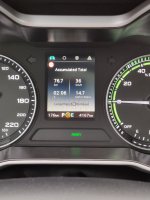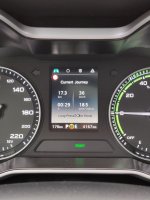Hi - from what I can gather from my little experience with electric cars is that the battery usage is down to a host of factors such as weather, temperature, what is drawing power (heating, lights, wipers, etc.), how 'hard' you accelerate and lots of others.
Basically, the consumption on the same trip may differ because it may not be replicated exactly - you may have accelerated harder a few more times than on other trips, or the wind may have changed direction and is now blowing against you (causing the engine to work harder and drawing more power), or the traffic may have been lighter (or heavier) than other trips so you are stopping and starting more, etc.
Obviously, you also have to factor in whether the batteries are warm (if they've just been charged) and the ground conditions - if there's snow / slush lying it won't be good for tyre efficiency I can only presume?
I'm sure others, with much more knowledge than I have, will chip in and maybe provide more info!
Cheers
Bloggsy
No different to ICE cars, ALL the factors you mention reduce or increase the mpg on both EV and ICE Cars. One factor however with an ICE car that is different , is the weight of the fuel, every time you fill up to full you increase the fuel consumption which gets better as you use the fuel. I am fairly sure a EV Battery weighs the same full or empty.
Everyone on this forum (well, maybe not everyone) seem obsessed with the range and how to maximise it, well, we all know how (just as an ICE car) drive really bloody slowly ( but simplistic but you get the gist) oh, and having heater, lights, radio A.C. etc etc also reduce the MPG on ICE cars, albeit if affects EV cars more.
I would never drive my car without the necessary ancillaries on and would only turn them off if absolutely necessary.
Buying a big gas guzzling V8/V12 is equal to buying a short range EV, you have to fill up more often and get less mileage!!!
Buying a 900cc equates to for example a Kia e-Niro or Kona.
The point I am really making is accept what is the possible range of your car under the worst case scenario, (including possible broken chargers) and just plan all journeys outside your return range carefully.
We all know that most of us will NEVER get near the manufacturers claimed mileage from their cars EV or ICE, I certainly never do. My last new petrol car was a 2019 MG ZS 1ltr Auto and I only got 22- 24 Mpg around town, I just put that down to a lead foot.
I never get range anxiety (unless I am about to run out, but in my opinion that is caused by poor planning so it's not really range anxiety it's a cock up). The problem I have got is simple, charger anxiety, which if you have ran an EV for any time you will know what I mean.
The only consoulation is that I am sure the public infrastructure will have improved dramatically in the next couple of years and also the way battery technology is improving (if you believe what you read) you may be able to charge your battery in not much more than it takes to fill up an ICE car. Also the 1000 Miles on one charge has been muted as possible in the next couple of years.
Happy motoring.
Frank

